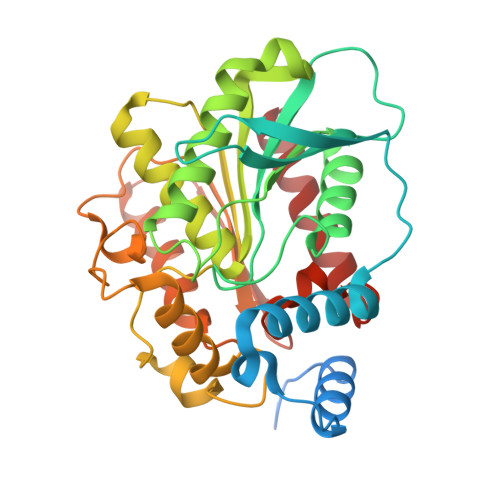From a metagenomic source to a high-resolution structure of a novel alkaline esterase.
Pereira, M.R., Maester, T.C., Mercaldi, G.F., de Macedo Lemos, E.G., Hyvonen, M., Balan, A.(2017) Appl Microbiol Biotechnol
- PubMed: 28331945
- DOI: https://doi.org/10.1007/s00253-017-8226-4
- Primary Citation of Related Structures:
4YPV - PubMed Abstract:
Esterases catalyze the cleavage and formation of ester bonds and are members of the diverse family of α/β hydrolase fold. They are useful in industries from different sectors, such as food, detergent, fine chemicals, and biofuel production. In a previous work, 30 positive clones for lipolytic activity were identified from a metagenomic library of a microbial consortium specialized in diesel oil degradation. In this study, a putative gene encoding an esterase/lipase, denominated est8, has been cloned and the corresponding protein expressed recombinantly, purified to homogeneity and characterized functional and structurally. We show that the protein codified by est8 gene, denominated Est8, is an alkaline esterase with high catalytic efficiency against p-nitrophenyl acetate and stable in the presence of up to 10% dimethyl sulfoxide. The three-dimensional structure of Est8 was determined at 1.85-Ǻ resolution, allowing the characterization of the substrate-binding pocket and features that rationalize the preference of Est8 for short-chain substrates. In an attempt to increase the size of ligand-binding pocket and enzyme activity against distinct substrates of long chain, we mutated two residues (Met 213 and Phe 217 ) that block the substrate channel. A small increase in the reaction velocity for p-nitrophenyl butyrate and p-nitrophenyl valerate hydrolysis was observed. Activity against p-nitrophenyl acetate was reduced. The functional and structural characterization of Est8 is explored in comparison with orthologues.
Organizational Affiliation:
National Laboratory of Biosciences (LNBio), Brazilian Center for Research in Energy and Materials (CNPEM), Campinas, São Paulo State, Brazil.


















